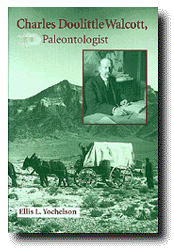 Charles Doolittle Walcott, Paleontologist
Charles Doolittle Walcott, Paleontologist
by Ellis L. Yechelson.
The Kent State University Press, Kent, OH 44242, 1998, 510 pages,
ISBN 0-87338-599-3, $49.00 (US).
Reviewed by Loren H. Smith,
Department of Biological Sciences, University of Southern California, Los Angeles, CA 90089, USA.
Most college-level texts in the fields of historical geology, evolutionary biology and paleontology present a skewed view of earth history. The geologic time scale generally consists of the Phanerozoic divided at various levels of detail, with a sliver of the “Precambrian” slapped on the bottom, not to scale, and generally without an indication of scale break ( e. g., the timescale). Occasionally this bias is addressed (usually in conjunction with a pithy metaphor demonstrating the relative paucity of time represented by the Phanerozoic), but given the intended audiences for most of these texts, the Phanerozoic is ‘where it is at’ and emphasis is duly placed there by the various authors. Of course, this is not to imply that the bias is intended to slight the Precambrian, for certainly it is difficult to nearly impossible to understand the last 600 million or so years of earth history without a firm understanding of the preceding three billion plus years of the Precambrian.
Readers of the new biography of Charles Doolittle Walcott may be disappointed that it essentially reverses the bias inherent in most representations of geologic time. The work ends in 1907, twenty years before his death, but only two years before the discovery of the Burgess Shale. However, any disappointment in this choice of stopping place should be well counterbalanced by the great detail with which Yochelson has set the stage for the better known events of Walcott’s life. In all truth, without this meticulous account of the early years it is likely that Walcott would be doomed to remain a fairly one dimensional character as the man who discovered and described the Burgess Shale. As the Precambrian is so much more than stromatolites and banded-iron formations, Walcott was so much more than the Burgess and its remarkable biota.
The 468 pages of text devoted to the first 57 years of Walcott’s life are a detailed catalog of personal, professional, political, financial and scientific events. Much of the history recounted is supported by the voluminous diaries that Walcott kept religiously throughout his life. In a single paragraph we discover Walcott the romantic, Walcott the astute politician, Walcott the paramount administrator, and even Walcott the paleontologist. The amazing journey taken by an itinerant farmer to the pantheons of American and international science continually astounds. Although many of Walcott’s predecessors and contemporaries also pulled themselves up by their bootstraps (Schuchert being another prime example), there are few comparable rags-to-riches stories of such scope. This biography allows us to ponder what made Walcott tick. How did an avid amateur collector who never gained a high-school diploma rise to the highest ranks of academic and professional life during this period of human history? What were the origins of his amazing political acumen? How did Walcott’s personal background affect his scientific views? The level of detail now available allows these and a myriad of other questions to be answered at long last.
If there is one minor difficulty with the biography, it is that little connection is made to the major events late in the life of Walcott. Again, as the Precambrian sets the stage for the Phanerozoic, Walcott’s early life is an important preamble to his directorship of the Smithsonian and discovery of the Burgess shale. The reader is left hanging at the end, with little sense of what is to come, or how to bridge the wealth of knowledge about Walcott’s ‘early’ life with the better known achievements yet to transpire. The Burgess Shale biota is not even mentioned in the text, and no references are made to more extensive discussions of its historical and paleontological importance.
All in all, however, Charles Doolittle Walcott, Paleontologist, presents a richly detailed exposition of the life of one of America’s most important practitioners of science. Slowly the importance of what has traditionally been viewed as ‘prehistory’ is being realized.
Copyright: Palaeontologia Electronica, 15 March 1999

